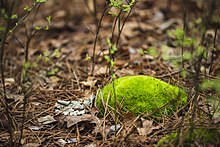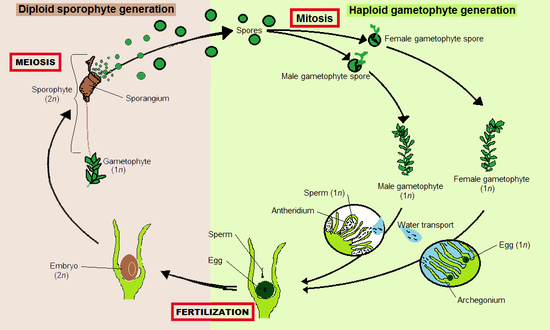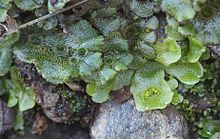Bryophyte


Bryophytes(/ˈbraɪ.əˌfaɪts/)[1]are a group ofland plants,sometimes treated as a taxonomicdivision,that contains three groups ofnon-vascularland plants (embryophytes): theliverworts,hornworts,andmosses.[2]In thestrict sense,the divisionBryophytaconsists of the mosses only. Bryophytes are characteristically limited in size and prefer moist habitats although some species can survive in drier environments.[3]The bryophytes consist of about 20,000 plant species.[4][5]Bryophytes produce enclosed reproductive structures (gametangia and sporangia), but they do not produceflowersorseeds.They reproduce sexually bysporesand asexually by fragmentation or the production ofgemmae.[6]Though bryophytes were considered aparaphyleticgroup in recent years, almost all of the most recentphylogeneticevidence supports themonophylyof this group, as originally classified byWilhelm Schimperin 1879.[7]The termbryophytecomes fromAncient Greekβρύον(brúon)'tree moss, liverwort', andφυτόν(phutón)'plant'.
Features[edit]
The defining features of bryophytes are:
- Their life cycles are dominated by a multicellularhaploidgametophytestage
- Theirsporophytesarediploidand unbranched
- They do not have a truevascular tissuecontaininglignin(although some have specialized tissues for the transport of water)[8]
Habitat[edit]
Bryophytes exist in a wide variety of habitats. They can be found growing in a range of temperatures (cold arctics and in hot deserts), elevations (sea-level to alpine), and moisture (dry deserts to wet rain forests). Bryophytes can grow where vascularized plants cannot because they do not depend on roots for uptake ofnutrients from soil.Bryophytes can survive on rocks and bare soil.[9]
Life cycle[edit]

Like all land plants (embryophytes), bryophytes havelife cycleswithalternation of generations.[10]In each cycle, a haploid gametophyte, each of whose cells contains a fixed number of unpairedchromosomes,alternates with a diploid sporophyte, whose cells contain two sets of paired chromosomes. Gametophytes produce haploid sperm and eggs which fuse to form diploid zygotes that grow into sporophytes. Sporophytes produce haploid spores bymeiosis,that grow into gametophytes.
Bryophytes are gametophyte dominant,[11]meaning that the more prominent, longer-lived plant is the haploid gametophyte. The diploid sporophytes appear only occasionally and remain attached to and nutritionally dependent on the gametophyte.[12]In bryophytes, the sporophytes are always unbranched and produce a singlesporangium(spore producing capsule), but each gametophyte can give rise to several sporophytes at once.
Liverworts, mosses and hornworts spend most of their lives as gametophytes.Gametangia(gamete-producing organs),archegoniaandantheridia,are produced on the gametophytes, sometimes at the tips of shoots, in the axils of leaves or hidden under thalli. Some bryophytes, such as the liverwortMarchantia,create elaborate structures to bear the gametangia that are called gametangiophores. Sperm are flagellated and must swim from the antheridia that produce them to archegonia which may be on a different plant. Arthropods can assist in transfer of sperm.[13]
Fertilized eggs become zygotes, which develop into sporophyte embryos inside the archegonia. Mature sporophytes remain attached to the gametophyte. They consist of a stalk called a seta and a single sporangium or capsule. Inside the sporangium, haploid spores are produced bymeiosis.These are dispersed, most commonly by wind, and if they land in a suitable environment can develop into a new gametophyte. Thus bryophytes disperse by a combination of swimming sperm and spores, in a manner similar tolycophytes,fernsand othercryptogams.
The sporophyte develops differently in the three groups. Both mosses and hornworts have ameristemzone where cell division occurs. In hornworts, the meristem starts at the base where the foot ends, and the division of cells pushes the sporophyte body upwards. In mosses, the meristem is located between the capsule and the top of the stalk (seta), and produces cells downward, elongating the stalk and elevating the capsule. In liverworts the meristem is absent and the elongation of the sporophyte is caused almost exclusively by cell expansion.[14]
Sexuality[edit]
The arrangement ofantheridiaandarchegoniaon an individual bryophyte plant is usually constant within a species, although in some species it may depend on environmental conditions. The main division is between species in which the antheridia and archegonia occur on the same plant and those in which they occur on different plants. The termmonoicousmay be used where antheridia and archegonia occur on the samegametophyteand the termdioicouswhere they occur on different gametophytes.[15]
Inseed plants,"monoecious"is used where flowers withanthers(microsporangia) and flowers withovules(megasporangia) occur on the samesporophyteand "dioecious"where they occur on different sporophytes. These terms occasionally may be used instead of" monoicous "and" dioicous "to describe bryophyte gametophytes." Monoecious "and" monoicous "are both derived from the Greek for" one house "," dioecious "and" dioicous "from the Greek for two houses. The use of the" -oicy "terminology refers to the gametophyte sexuality of bryophytes as distinct from the sporophyte sexuality of seed plants.[15]
Monoicous plants are necessarily hermaphroditic, meaning that the same plant produces gametes of both sexes.[15]The exact arrangement of the antheridia and archegonia in monoicous plants varies. They may be borne on different shoots (autoicous), on the same shoot but not together in a common structure (paroicous or paroecious), or together in a common "inflorescence" (synoicous or synoecious).[15][16]Dioicous plants areunisexual,meaning that an individual plant has only one sex.[15]All four patterns (autoicous, paroicous, synoicous and dioicous) occur in species of the moss genusBryum.[16]
Classification and phylogeny[edit]


Traditionally, all living land plants without vascular tissues were classified in a single taxonomic group, often adivision(or phylum). The term "Bryophyta" was first suggested by Braun in 1864.[17]As early as 1879, the term Bryophyta was used by German bryologist Wilhelm Schimper to describe a group containing all three bryophyte clades (though at the time, hornworts were considered part of the liverworts).[18][7]G.M. Smithplaced this group between Algae andPteridophyta.[19]Although a 2005 study supported this traditional monophyletic view,[20]by 2010 a broad consensus had emerged among systematists that bryophytes as a whole are not a natural group (i.e., areparaphyletic).[21][22][23]However, a 2014 study concluded that these previous phylogenies, which were based on nucleic acid sequences, were subject to composition biases, and that, furthermore, phylogenies based on amino acid sequences suggested that the bryophytes are monophyletic after all.[24]Since then, partially thanks to a proliferation of genomic and transcriptomic datasets, almost all phylogenetics studies based on nuclear and chloroplastic sequences have concluded that the bryophytes form a monophyletic group.[24][25][18][26][27][28][29][30][31]Nevertheless, phylogenies based on mitochondrial sequences fail to support the monophyletic view.[32]
The three bryophytecladesare theMarchantiophyta(liverworts),Bryophyta(mosses) andAnthocerotophyta(hornworts).[33]However, it has been proposed that these clades are de-ranked to the classes Marchantiopsida, Bryopsida, and Anthocerotopsida, respectively.[18]There is now strong evidence that the liverworts and mosses belong to a monophyletic clade, calledSetaphyta.[25][32][34]
Monophyletic view[edit]
The favored model, based on amino acids phylogenies, indicates bryophytes as a monophyletic group:[24]
| embryophytes |
| ||||||
Consistent with this view, compared to other living land plants, all three lineages lack vascular tissue containing lignin and branched sporophytes bearing multiple sporangia. The prominence of the gametophyte in the life cycle is also a shared feature of the three bryophyte lineages (extant vascular plants are all sporophyte dominant). However, if this phylogeny is correct, then the complex sporophyte of living vascular plants might have evolved independently of the simpler unbranched sporophyte present in bryophytes.[24]Furthermore, this view implies thatstomataevolved only once in plant evolution, before being subsequently lost in the liverworts.[25][28]
Paraphyletic view[edit]
|
bryophytes |

In this alternative view, the Setaphyta grouping is retained, but hornworts instead are sister to vascular plants.[34](Another paraphyletic view involves hornworts branching out first.)[32]
Traditional morphology[edit]
Traditionally, when basing classifications on morphological characters, bryophytes have been distinguished by their lack of vascular structure. However, this distinction is problematic, firstly because some of the earliest-diverging (but now extinct) non-bryophytes, such as thehorneophytes,did not have true vascular tissue, and secondly because many mosses have well-developed water-conducting vessels.[35][36]A more useful distinction may lie in the structure of theirsporophytes.In bryophytes, the sporophyte is a simple unbranched structure with a single spore-forming organ (sporangium), whereas in all other land plants, thepolysporangiophytes,the sporophyte is branched and carries many sporangia.[37][38]The contrast is shown in the cladogram below:[39]
| land plants |
| |||||||||||||||
Evolution[edit]
There have probably been several different terrestrialization events, in which originally aquatic organisms colonized the land, just within the lineage of theViridiplantae.[40]Between 510–630 million years ago, however, land plants emerged within thegreen algae.[41]Molecular phylogenetic studies conclude that bryophytes are the earliest diverging lineages of the extant land plants.[42][2][43][44]They provide insights into the migration of plants from aquatic environments to land. A number of physical features link bryophytes to both land plants and aquatic plants.[45]
Similarities to algae and vascular plants[edit]
Green algae, bryophytes and vascular plants all have chlorophyll a and b, and the chloroplast structures are similar.[46]Like green algae and land plants, bryophytes also produce starch stored in the plastids and contain cellulose in their walls.[46]Distinct adaptations observed in bryophytes have allowed plants to colonize Earth's terrestrial environments. To prevent desiccation of plant tissues in a terrestrial environment, a waxy cuticle covering the soft tissue of the plant may be present, providing protection. In hornworts and mosses, stomata provide gas exchange between the atmosphere and an internal intercellular space system. The development of gametangia provided further protection specifically for gametes, the zygote and the developing sporophyte.[47]The bryophytes and vascular plants (embryophytes) also have embryonic development which is not seen in green algae.[46]While bryophytes have no truly vascularized tissue, they do have organs that are specialized for transport of water and other specific functions, analogous for example to the functions of leaves and stems in vascular land plants.[46]
Bryophytes depend on water for reproduction and survival. In common with ferns andlycophytes,a thin layer of water is required on the surface of the plant to enable the movement of the flagellated sperm between gametophytes and the fertilization of an egg.[47]
Comparative morphology[edit]
Summary of the morphological characteristics of thegametophytesof the three groups of bryophytes:
| Liverworts | Mosses | Hornworts | |
|---|---|---|---|
| Structure | Thalloidor foliose | Foliose | Thalloid |
| Symmetry | Dorsiventralorradial | Radial | Dorsiventral |
| Rhizoids | Unicellular | Pluricellular | Unicellular |
| Chloroplasts/cell | Many | Many | One |
| Protonemata | Reduced | Present | Absent |
| Gametangia (antheridia andarchegonia) |
Superficial | Superficial | Immersed |
Summary of the morphological characteristics of thesporophytesof the three groups of bryophytes:
| Liverworts | Mosses | Hornworts | |
|---|---|---|---|
| Stomata | Absent | Present | Present |
| Structure | Small, without chlorophyll | Large, with chlorophyll | Large, with chlorophyll |
| Persistence | Ephemeral | Persistent | Persistent |
| Growth | Defined | Defined | Continuous |
| Apical growth[48] | Absent | Present | Absent |
| Seta | Present | Present | Absent |
| Capsuleform | Simple | Differentiated (operculum,peristome) |
Elongated |
| Maturation of spores | Simultaneous | Simultaneous | Gradual |
| Dispersion of spores | Elaters | Peristome teeth | Pseudo-elaters |
| Columella | Absent | Present | Present |
| Dehiscence | Longitudinal or irregular | Transverse | Longitudinal |
Uses[edit]
Environmental
- Soil Conditioning
- Bioindicators
- Moss gardens
- Pesticides
Characteristics of bryophytes make them useful to the environment. Depending on the specific plant texture, bryophytes have been shown to help improve the water retention and air space within soil.[49]Bryophytes are used in pollution studies to indicate soil pollution (such as the presence of heavy metals), air pollution, and UV-B radiation.[49]Gardens in Japan are designed with moss to create peaceful sanctuaries.[49]Some bryophytes have been found to produce natural pesticides. The liverwort,Plagiochila,produces a chemical that is poisonous to mice.[49]Other bryophytes produce chemicals that are antifeedants which protect them from being eaten by slugs.[49]WhenPhythium sphagnumis sprinkled on the soil of germinating seeds, it inhibits growth of "damping off fungus" which would otherwise kill young seedlings.[50]

Commercial
- Fuel
- Packaging
- Wound Dressing
Peatis a fuel produced from dried bryophytes, typicallySphagnum.Bryophytes' antibiotic properties and ability to retain water make them a useful packaging material for vegetables, flowers, and bulbs.[49]Also, because of its antibiotic properties,Sphagnumwas used as a surgical dressing in World War I.[49]
See also[edit]
References[edit]
- ^"bryophyte".Dictionary Unabridged(Online). n.d.
- ^abHedges, S. Blair (November 2002). "The origin and evolution of model organisms".Nature Reviews Genetics.3(11): 838–849.doi:10.1038/nrg929.PMID12415314.S2CID10956647.
- ^Levetin, Estelle; McMahon, Karen (2012).Plants and Society.New York, NY: McGraw-Hill. p. 139.ISBN978-0-07-352422-1.
- ^"Bryophytes (Mosses and liverworts) — The Plant List".theplantlist.org.Retrieved2017-04-11.
- ^"What are Bryophytes".Southern Illinois University Carbondale.Archived fromthe originalon 2018-10-19.Retrieved2009-05-31.
- ^Vanderpoorten, Alain; Goffinet, Bernard (2009).Introduction to Bryophytes.Cambridge:Cambridge University Press.p. 3.ISBN978-0-511-54013-4.
- ^abSchimper, W.P. (1879). "Bryophyta". In Zittel, K.A. (ed.).Handbuch der Palaeontologie.Vol. 2. R. Oldenbourg.
- ^Lucas, William J.; Groover, Andrew; Lichtenberger, Raffael; Furuta, Kaori; Yadav, Shri-Ram; Helariutta, Ykä; He, Xin-Qiang; Fukuda, Hiroo; Kang, Julie;Brady, Siobhan M.;Patrick, John W. (April 2013). "The Plant Vascular System: Evolution, Development and Functions F".Journal of Integrative Plant Biology.55(4): 294–388.doi:10.1111/jipb.12041.hdl:10261/76903.PMID23462277.
- ^Lepp, Heino (28 February 2008)."Habitats".Australian Bryophytes.Australian National Botanic Gardens.
- ^Ligrone, Roberto; Duckett, Jeffrey G.; Renzaglia, Karen S. (April 2012)."Major transitions in the evolution of early land plants: a bryological perspective".Annals of Botany.109(5): 851–871.doi:10.1093/aob/mcs017.PMC3310499.PMID22356739.
- ^C.M. Sean Carrington (2013-11-04)."The Bryophytes".The University of the West Indies. Archived fromthe originalon 2020-02-05.Retrieved2020-03-05.
- ^Johnson, M G; Shaw, A J (24 February 2016)."The effects of quantitative fecundity in the haploid stage on reproductive success and diploid fitness in the aquatic peat moss Sphagnum macrophyllum".Heredity.116(6): 523–530.doi:10.1038/hdy.2016.13.PMC4868265.PMID26905464.
- ^Cronberg, N.; Natcheva, R.; Hedlund, K. (2006). "Microarthropods Mediate Sperm Transfer in Mosses".Science.313(5791): 1255.doi:10.1126/science.1128707.PMID16946062.S2CID11555211.
- ^Ueli Grossniklaus (2019).Plant Development and Evolution.Academic Press. p. 13.ISBN9780128098059.
- ^abcdeGlime, J.M. & Bisang, I. (2014)."Sexuality: Its Determination (Ch. 3-1)"(PDF).In Glime, J.M. (ed.).Bryophyte Ecology.Vol. 1 Physiological Ecology. Michigan Technological University and the International Association of Bryologists.Retrieved2014-11-09.
- ^abWatson, E.V. (1981).British Mosses and Liverworts(3rd ed.). Cambridge University Press. p. 7.ISBN9780521285360.(Watson uses the "oecy" terms rather than the "oicy" terms.)
- ^"Phylum Bryophyta – Hierarchy".Taxonomicon.
- ^abcde Sousa, Filipe; et al. (2019). "Nuclear protein phylogenies support the monophyly of the three bryophyte groups (Bryophyta Schimp.)".New Phytologist.222(1): 565–575.doi:10.1111/nph.15587.hdl:1983/0b471d7e-ce54-4681-b791-1da305d9e53b.PMID30411803.S2CID53240320.
- ^Smith, G.M. (1955).Cryptogamic Botany.Vol. 2 (2nd ed.). New York: McGraw-Hill.
- ^Goremykin, V. V. & Hellwig, F. H. (2005). "Evidence for the most basal split in land plants dividing bryophyte and tracheophyte lineages".Plant Systematics and Evolution.254(1–2): 93–103.doi:10.1007/s00606-005-0337-1.S2CID41403901.
- ^Konrat, M.; Shaw, A.J.; Renzaglia, K.S. (2010)."A special issue ofPhytotaxadedicated to Bryophytes: The closest living relatives of early land plants ".Phytotaxa.9:5–10.doi:10.11646/phytotaxa.9.1.3.
- ^Troitsky, A. V.; Ignatov, M. S.; Bobrova, V. K.; Milyutina, I. A. (December 2007). "Contribution of genosystematics to current concepts of phylogeny and classification of bryophytes".Biochemistry (Moscow).72(12): 1368–1376.doi:10.1134/s0006297907120115.PMID18205621.S2CID13509400.
- ^Knoop, Volker (31 December 2010). "Looking for sense in the nonsense: a short review of non-coding organellar DNA elucidating the phylogeny of bryophytes".Bryophyte Diversity and Evolution.31(1): 51–60.doi:10.11646/bde.31.1.10.
- ^abcdCox, Cymon J.; et al. (2014)."Conflicting Phylogenies for Early Land Plants are Caused by Composition Biases among Synonymous Substitutions".Systematic Biology.63(2): 272–279.doi:10.1093/sysbio/syt109.PMC3926305.PMID24399481.
- ^abcPuttick, Mark N.; et al. (2018). "The Interrelationships of Land Plants and the Nature of the Ancestral Embryophyte".Current Biology.28(5): 733–745.e2.doi:10.1016/j.cub.2018.01.063.hdl:1983/ad32d4da-6cb3-4ed6-add2-2415f81b46da.PMID29456145.S2CID3269165.
- ^Leebens-Mack, James H.; et al. (2019)."One thousand plant transcriptomes and the phylogenomics of green plants".Nature.574(7780): 679–685.doi:10.1038/s41586-019-1693-2.PMC6872490.PMID31645766.
- ^Zhang, Jian; et al. (2020)."The hornwort genome and early land plant evolution".Nature Plants.6(2): 107–118.doi:10.1038/s41477-019-0588-4.PMC7027989.PMID32042158.
- ^abHarris, Brogan J.; et al. (2020). "Phylogenomic Evidence for the Monophyly of Bryophytes and the Reductive Evolution of Stomata".Current Biology.30(11): P2201–2012.E2.doi:10.1016/j.cub.2020.03.048.hdl:1983/fbf3f371-8085-4e76-9342-e3b326e69edd.PMID32302587.S2CID215798377.
- ^Li, Fay-Wei; et al. (2020)."Anthoceros genomes illuminate the origin of land plants and the unique biology of hornworts".Nature Plants.6(3): 259–272.doi:10.1038/s41477-020-0618-2.hdl:10261/234303.PMC8075897.PMID32170292.
- ^Sousa, Filipe; et al. (2020)."The Chloroplast Land Plant Phylogeny: Analyses Employing Better-Fitting Tree- and Site-Heterogeneous Composition Models".Frontiers in Plant Science.11:1062.doi:10.3389/fpls.2020.01062.PMC7373204.PMID32760416.
- ^Su, Danyan; et al. (2021)."Large-Scale Phylogenomic Analyses Reveal the Monophyly of Bryophytes and Neoproterozoic Origin of Land Plants".Molecular Biology and Evolution.38(8): 3332–3344.doi:10.1093/molbev/msab106.PMC8321542.PMID33871608.
- ^abcSousa, Filipe; et al. (2020)."The mitochondrial phylogeny of land plants shows support for Setaphyta under composition-heterogeneous substitution models".PeerJ.8(4): e8995.doi:10.7717/peerj.8995.PMC7194085.PMID32377448.
- ^"GLOSSARY B".Archived fromthe originalon 2009-04-02.Retrieved2009-03-26.
- ^abCox, Cymon J. (2018). "Land Plant Molecular Phylogenetics: A Review with Comments on Evaluating Incongruence Among Phylogenies".Critical Reviews in Plant Sciences.37(2–3): 113–127.doi:10.1080/07352689.2018.1482443.hdl:10400.1/14557.S2CID92198979.
- ^Bell, N. E. & Hyvönen, J. (2010)."Phylogeny of the moss class Polytrichopsida (BRYOPHYTA): Generic-level structure and incongruent gene trees".Molecular Phylogenetics and Evolution.55(2): 381–398.doi:10.1016/j.ympev.2010.02.004.PMID20152915.
- ^Bodribb, T.J.; et al. (2020). "Advanced vascular function discovered in a widespread moss".Nature Plants.6(3): 273–279.doi:10.1038/s41477-020-0602-x.PMID32170283.S2CID212641738.
- ^Kenrick, Paul & Crane, Peter R. (1997a).The Origin and Early Diversification of Land Plants: A Cladistic Study.Washington, D.C.: Smithsonian Institution Press.ISBN978-1-56098-730-7.
- ^Kenrick, P. & Crane, P.R. (1997b). "The origin and early evolution of plants on land".Nature.389(6646): 33–39.Bibcode:1997Natur.389...33K.doi:10.1038/37918.S2CID3866183.
- ^Crane, Peter R.; Herendeen, Patrick; Friis, Else Marie (October 2004)."Fossils and plant phylogeny".American Journal of Botany.91(10): 1683–1699.doi:10.3732/ajb.91.10.1683.PMID21652317.
- ^Gerrienne, Philippe; Servais, Thomas; Vecoli, Marco (April 2016). "Plant evolution and terrestrialization during Palaeozoic times—The phylogenetic context".Review of Palaeobotany and Palynology.227:4–18.doi:10.1016/j.revpalbo.2016.01.004.
- ^Delwiche, Charles F.; Timme, Ruth E. (2011-06-07)."Plants".Current Biology.21(11): R417–R422.doi:10.1016/j.cub.2011.04.021.ISSN0960-9822.PMID21640897.S2CID235312105.
- ^Konrat, M.; Shaw, A.J.; Renzaglia, K.S. (2010)."A special issue ofPhytotaxadedicated to Bryophytes: The closest living relatives of early land plants ".Phytotaxa.9:5–10.doi:10.11646/phytotaxa.9.1.3.
- ^Karol, Kenneth G.; Arumuganathan, Kathiravetpillai; Boore, Jeffrey L.; Duffy, Aaron M.; Everett, Karin DE; Hall, John D.; Hansen, S.K.; Kuehl, Jennifer V.; Mandoli, Dina F.; Mishler, Brent D.; Olmstead, Richard G.; Renzaglia, Karen S. & Wolf, Paul G. (2010)."Complete plastome sequences of Equisetum arvense and Isoetes flaccida: implications for phylogeny and plastid genome evolution of early land plant lineages".BMC Evolutionary Biology.10(1): 321.doi:10.1186/1471-2148-10-321.PMC3087542.PMID20969798.
- ^Shaw, A. Jonathan; Szövényi, Péter; Shaw, Blanka (March 2011). "Bryophyte diversity and evolution: Windows into the early evolution of land plants".American Journal of Botany.98(3): 352–369.doi:10.3732/ajb.1000316.PMID21613131.
- ^Donoghue, Philip C. J.; Harrison, C. Jill; Paps, Jordi; Schneider, Harald (11 October 2021)."The evolutionary emergence of land plants".Current Biology.31(19): R1281–R1298.doi:10.1016/j.cub.2021.07.038.hdl:1983/662d176e-fcf4-40bf-aa8c-5694a86bd41d.PMID34637740.S2CID238588736.
- ^abcdEvert, Ray; Eichhorn, Susan (2013).Biology of Plants.W.H.Freeman and Company Publishers.
- ^abPurcell, Adam."Bryophytes".Basic Biology.
- ^How was apical growth regulated in the ancestral land plant? Insights from the development of non-seed plants
- ^abcdefgGlime, Janice."Economic and Ethnic Uses of Bryophytes"(PDF).harvard.edu.
- ^Wolffhechel, H. (April 1988). "The suppressiveness of sphagnum peat toPythiumspp ".Acta Horticulturae(221): 217–222.doi:10.17660/actahortic.1988.221.22.
Bibliography[edit]
- Lesica, P.; McCune, B.; Cooper, S. V.; Hong, W. S. (1991). "Differences in lichen and bryophyte communities between old-growth and managed second-growth forests in the Swan Valley, Montana".Canadian Journal of Botany.69(8): 1745–1755.doi:10.1139/b91-222.
External links[edit]
- Andrew's Moss SitePhotos of bryophytes
- 27-May-2013Centuries-old frozen plants revived,400-year-old bryophyte specimens left behind byretreating glaciersin Canada are brought back to life in the laboratory.
- Farge, Catherine La; Williams, Krista H.; England, John H. (22 May 2013)."Regeneration of Little Ice Age bryophytes emerging from a polar glacier with implications of totipotency in extreme environments".Proceedings of the National Academy of Sciences.110(24): 9839–9844.Bibcode:2013PNAS..110.9839L.doi:10.1073/pnas.1304199110.PMC3683725.PMID23716658.
- Magill, R. E., ed. (1990).Glossarium polyglottum bryologiae. A multilingual glossary for bryology.Monographs in Systematic Botany from the Missouri Botanical Garden, v. 33, 297 pp.Online version: Internet Archive.
